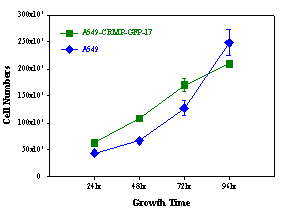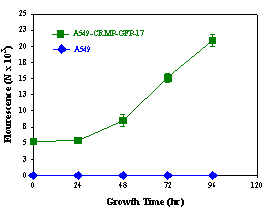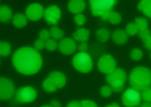CRMP-1
promoter/GFP Reporter Cells
|
Cat.
No. PCE001
|
Cell
|
Contents
Human lung adenocarcinoma cell A549 was transfected stably
with the DNA construct, EGFP-hcrmp1, containing 1.9 kb of promoter
region of CRMP-1 gene and the reporter (GFP) gene.
The promoter fragment was inserted into the multiple
cloning site of pEGFP-1 plasmid (BD Biosciences; Ref. 1).
Product
Information
CRMP-1
promoter/GFP Reporter Cells are homogenous and show proportional
increase of fluorescent intensity (Figure 2) during cell growth
(Figure 1). Microscopic
analysis indicates that at least over 90% of GFP-expressing cells
deliver detectable fluorescent signal (Figure 3).
|
Figure 1: Growth curve.
|
Figure 2: Fluorescence signal.
|

|

|
Figure 3: Microscopic Images.

|

|
|
(Suspension)
|
(adherent Cells)
|
Applications
Screening for agents or compounds, which could induce the
expression of hCRMP-1. The
increase of GFP signal after treatment of CRMP-1 promoter/GFP
Reporter Cells indirectly means the up-regulation of hCRMP-1
level. This system
will be very suitable for screening active agents, which might be
involved in the regulation or related pathways.
Background
information
Human CRMP-1 was reported as “a lung cancer invasion
suppressor gene with nerve” (Ref. 2).
Recent discovery showed that the level of expression of the
gene encoding CRMP-1 inversely affects cancer invasion and
metastasis, (i.e., the higher the level of expression, the
lower the incidence of cancer invasion and metastasis) and thus
characterized the CRMP-1 gene as an invasion-suppression gene
(Ref. 3-5). Further analysis of around 50 cases of clinical lung tissue
samples using real time-quantitative PCR techniques found that
low-expression patients of CRMP-1 had more advanced diseases and
lymph node metastases, while high-expression patients of CRMP-1
had a significantly longer disease-free and overall survival
period. “CRMP-1
as an excellent target for lung cancer” was interpreted by
the web “bioportfolio” (Ref. 6).
References
(1) pEGFP-1
(BD Biosciences; http://orders.clontech.com/clontech/techinfo/vectors_dis/pEGFP-1.shtml
(2)
Steeg (2001) J. Natl. Cancer Inst. (2001), 93(18): 1364-1365
(3)
Shih et al., J. Natl. Cancer Inst. (2001), 93(18):
1392-1400.
(4)
Chu et al., Am. J. Respir. Cell Mol. Biol. (1997),
17:353-360.
(5)
Shih et al., Clinical & Exper. Metastasis (2003) 20:
69-76).
(6)
CRMP-1 as an excellent target for lung cancer
http://www.bioportfolio.com/LeadDiscovery/Pubmed-110112.htm
|

